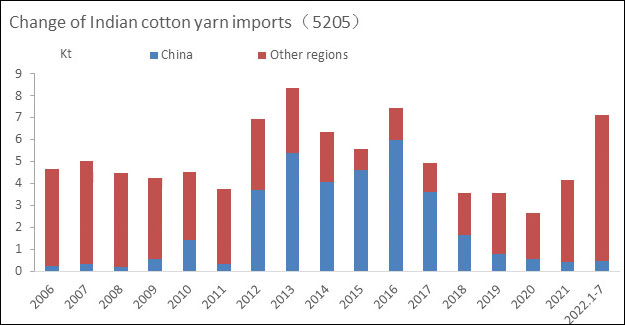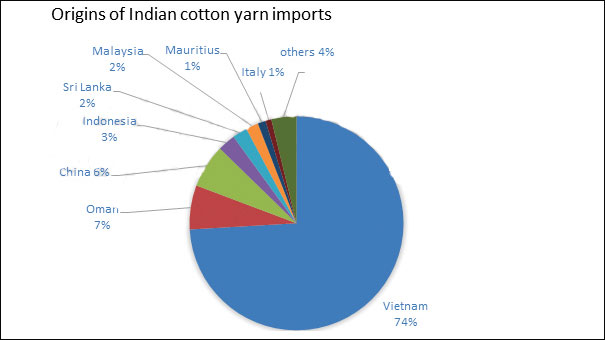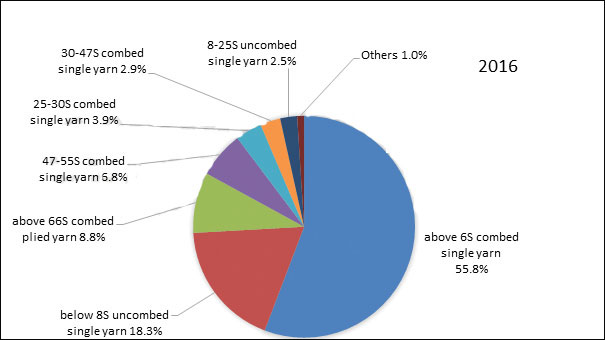
Indian Mills Imported Cotton Yarns To Tide Over Uncompetitive Local Pricing
Forward imported yarn prices have been far higher than domestic prices for a long time this year, making China-origin cotton yarn among the cheapest around the world. In addition to the ban on Xinjiang cotton, some brand manufacturers selling Xinjiang cotton products exported to US, Europe and Japan were restrained, which made domestic mills and traders actively look for other ways to consume the stocks.
Enlarging the export of cotton yarn and cotton fabric becomes a great choice. Indeed, prices of China-origin cotton yarn exported to India are lower than Indian local prices during the period when forward imported yarn prices were far higher than domestic one. However, current Indian local cotton yarn prices basically stay flat with China-origin one in line with the great falling of Indian cotton prices. The space for China-origin cotton yarn exported to Indian will not be great as there is high customs duty reaching 11%.
 Indian cotton yarn imports are mostly above 4Kt, and the imports in 2013 and 2016 reached 8.35kt and 7.44Kt respectively. The imports continued to fall during 2017-2020. The imports increased slightly last year, but were still below 4Kt. During January-July this year, Indian cotton yarn imports have reached 7.11Kt. There are still five months left this year, and Indian cotton yarn imports are expected to reach new high this year.
Where did India import cotton yarns?
Major origins of Indian cotton yarn imports from January to July this year are Vietnam, followed by Oman, and China ranks third, which is a big change compared with previous years. This year, India mainly imported 8-25S uncombed single yarn, accounting for 60%, followed by 30-47S uncombed single yarn, accounting for about 10%, while yarn with other counts accounted for the rest.
Indian cotton yarn imports are mostly above 4Kt, and the imports in 2013 and 2016 reached 8.35kt and 7.44Kt respectively. The imports continued to fall during 2017-2020. The imports increased slightly last year, but were still below 4Kt. During January-July this year, Indian cotton yarn imports have reached 7.11Kt. There are still five months left this year, and Indian cotton yarn imports are expected to reach new high this year.
Where did India import cotton yarns?
Major origins of Indian cotton yarn imports from January to July this year are Vietnam, followed by Oman, and China ranks third, which is a big change compared with previous years. This year, India mainly imported 8-25S uncombed single yarn, accounting for 60%, followed by 30-47S uncombed single yarn, accounting for about 10%, while yarn with other counts accounted for the rest.
 The two types of cotton yarn imports that accounted for the largest proportion in the same period last year were 25-30S combed single yarn and 8-25S uncombed single yarn. In 2016, Indian 66S combed single cotton yarn imported from China accounted for 55.8%, while high-count single yarn did not reach one ton from January to July 2022. On the contrary, the proportion of low-count uncombed single yarn rose significantly, which may be mainly because a part of consumption has been downgraded or transformed due to high price of long stapled cotton.
To sum up, though Indian cotton yarn imports are not much, the imports are expected to reach new high this year as previous Indian cotton prices were far higher than global cotton prices for a long time. India’s imports of cotton yarn will significantly fall in the coming months, as cotton prices reach reasonable levels. As for China-origin cotton yarn exported to India, the time window of it may gradually close.
The two types of cotton yarn imports that accounted for the largest proportion in the same period last year were 25-30S combed single yarn and 8-25S uncombed single yarn. In 2016, Indian 66S combed single cotton yarn imported from China accounted for 55.8%, while high-count single yarn did not reach one ton from January to July 2022. On the contrary, the proportion of low-count uncombed single yarn rose significantly, which may be mainly because a part of consumption has been downgraded or transformed due to high price of long stapled cotton.
To sum up, though Indian cotton yarn imports are not much, the imports are expected to reach new high this year as previous Indian cotton prices were far higher than global cotton prices for a long time. India’s imports of cotton yarn will significantly fall in the coming months, as cotton prices reach reasonable levels. As for China-origin cotton yarn exported to India, the time window of it may gradually close.

Textile Excellence
If you wish to Subscribe to Textile Excellence Print Edition, kindly fill in the below form and we shall get back to you with details.








